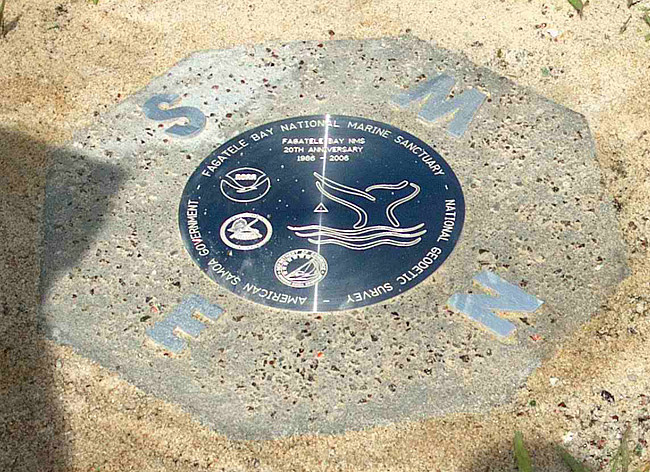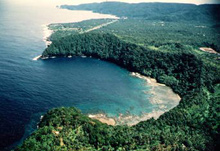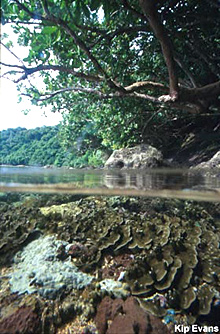 Lewis and Clark Corps of Discovery Bicentennial
Lewis and Clark Corps of Discovery Bicentennial 2002 Winter Olympics – Salt Lake City
2002 Winter Olympics – Salt Lake City U.S. Center of Population: 2000
U.S. Center of Population: 2000 NOAA Heritage Trail: The Calais Observatory
NOAA Heritage Trail: The Calais Observatory Ocean in View! The Nation's Newest Nickel
Ocean in View! The Nation's Newest Nickel 100th Anniversary of the First Flight
100th Anniversary of the First Flight 50th Anniversary of the Fredericksburg Geomagnetic Center
50th Anniversary of the Fredericksburg Geomagnetic Center Fagatele Bay National Marine Sanctuary, American Samoa
Fagatele Bay National Marine Sanctuary, American Samoa Pago Pago Harbor, American Samoa
Pago Pago Harbor, American Samoa Kilauea Point National Wildlife Refuge, Hawaii
Kilauea Point National Wildlife Refuge, Hawaii Hassler Park
Hassler Park 100th Anniversary of the U.S. Forest Service
100th Anniversary of the U.S. Forest Service National Estuarine Research Reserve System
National Estuarine Research Reserve System Hawaiian Islands Humpback Whale National Marine Sanctuary
Hawaiian Islands Humpback Whale National Marine Sanctuary
Fagatele Bay National Marine Sanctuary, American Samoa
This commemorative disk was set in Futiga Village, American Samoa, in April 2006, to celebrate the 20th anniversary of the Fagatele Bay National Marine Sanctuary.


Fagatele Bay National Marine Sanctuary is comprised of a fringing coral reef ecosystem nestled within an eroded volcanic crater on the island of Tutuila, American Samoa.

Fagatele Bay National Marine Sanctuary protects an extensive coral reef ecosystem. To date, over 600 species of corals, macroinvertebrates, fish, and microalgae have been recorded in the bay's waters.
This commemorative disk was set in Futiga Village, American Samoa, in April 2006, to celebrate the 20th anniversary of the Fagatele Bay National Marine Sanctuary. Fagatele Bay National Marine Sanctuary comprises a fringing coral reef ecosystem nestled within an eroded volcanic crater on the island of Tutuila, American Samoa. This smallest and most remote of all the National Marine Sanctuaries, tt was designated as a sanctuary on April 29, 1986.
The setting of the disk was a cooperative event between NOAA's National Marine Sanctuary Program, NOAA Pacific Services Center, and the American Samoa government.
Historic Reference
Fagatele Bay National Marine Sanctuary provides a home to a wide variety of animals and plants that thrive in the protected waters of the bay. The coral reef ecosystem found in the Sanctuary contains many of the species native to this part of the Indo-Pacific biogeographic region.
Fagatele Bay is filled with all sorts of brightly colored tropical fish including parrot fish, damselfish, and butterfly fish, as well as other sea creatures like lobster, crabs, sharks, and octopus. From June to September, Southern humpback whales migrate north from Antarctica to calve and court in Samoan waters. Several species of dolphin, as well as threatened and endangered species of sea turtles, such as the hawksbill and green sea turtle, are frequently seen swimming in the bay as well.
In the late 1970s, a massive outbreak of crown-of-thorns starfish attacked the reef, destroying about 90 percent of the coral. In addition, the reef has also been battered by two major hurricanes (1990 and 1991) and is recovering from a bleaching event (1993 and 1994). However, new growth is everywhere and the rich diversity of coral is being replenished. This natural cycle of growth and destruction is typical of a tropical ecosystem.
- Designation: Not yet in database
- PID: Not yet in database
- Year: 2006
- Location: Futiga Village, American Samoa
- Latitude/Longitude: Not yet in database
- Event Commemorated: 20th anniversary of the Fagatele Bay National Marine Sanctuary
Related Web Sites:
Fagatele Bay National Marine Sanctuary
